Moons of Saturn
The moons of Saturn are numerous and diverse, ranging from tiny moonlets only tens of meters across to enormous Titan, which is larger than the planet Mercury. Saturn has 82 moons with confirmed orbits that are not embedded in its rings – of which only 13 have diameters greater than 50 kilometers – as well as dense rings that contain millions of embedded moonlets and innumerable smaller ring particles. Seven Saturnian moons are large enough to have collapsed into a relaxed, ellipsoidal shape, though only one or two of those, Titan and possibly Rhea, are currently in hydrostatic equilibrium. Particularly notable among Saturn's moons are Titan, the second-largest moon in the Solar System (after Jupiter's Ganymede), with a nitrogen-rich Earth-like atmosphere and a landscape featuring dry river networks and hydrocarbon lakes, Enceladus, which emits jets of gas and dust from its south-polar region, and Iapetus, with its contrasting black and white hemispheres.
Twenty-four of Saturn's moons are regular satellites; they have prograde orbits not greatly inclined to Saturn's equatorial plane. They include the seven major satellites, four small moons that exist in a trojan orbit with larger moons, two mutually co-orbital moons and two moons that act as shepherds of Saturn's F Ring. Two other known regular satellites orbit within gaps in Saturn's rings. The relatively large Hyperion is locked in a resonance with Titan. The remaining regular moons orbit near the outer edge of the A Ring, within G Ring and between the major moons Mimas and Enceladus. The regular satellites are traditionally named after Titans and Titanesses or other figures associated with the mythological Saturn.
The remaining 58, with mean diameters ranging from 4 to 213 km, are irregular satellites, whose orbits are much farther from Saturn, have high inclinations, and are mixed between prograde and retrograde. These moons are probably captured minor planets, or debris from the breakup of such bodies after they were captured, creating collisional families. The irregular satellites have been classified by their orbital characteristics into the Inuit, Norse, and Gallic groups, and their names are chosen from the corresponding mythologies, with one exception: Phoebe (part of the Norse group but named for a Greek Titaness), the ninth moon of Saturn and largest irregular, discovered at the end of the 19th century.
The rings of Saturn are made up of objects ranging in size from microscopic to moonlets hundreds of meters across, each in its own orbit around Saturn. Thus a precise number of Saturnian moons cannot be given, because there is no objective boundary between the countless small anonymous objects that form Saturn's ring system and the larger objects that have been named as moons. Over 150 moonlets embedded in the rings have been detected by the disturbance they create in the surrounding ring material, though this is thought to be only a small sample of the total population of such objects.
There are still 29 unnamed moons (as of October 2019). If named, they will receive names from Gallic, Norse and Inuit mythology based on the orbital groups of the moons. Twenty of these moons are in line to receive permanent designations, with seventeen Norse, two Inuit, and one Gallic name expected.
Check out these Nanowerk News on moons of Saturn:
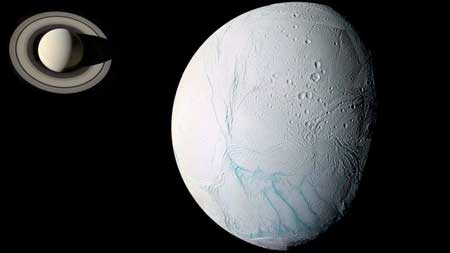 |
Could one of Saturn's moons support life? |
| The discovery of complex molecules from one of Saturn's moons suggests that it could support life. | |
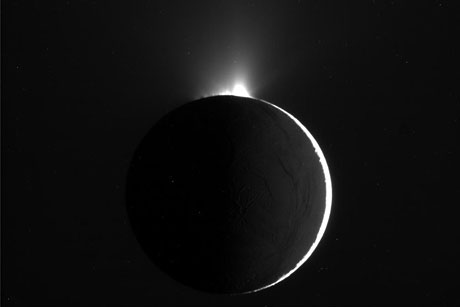 |
Saturn moon's mystery plume influenced by tides |
| Using Cassini data, astronomers have determined that the amount of water vapor and ice erupting from Enceladus depends on tidal forces from Saturn - the same phenomenon that creates tides on Earth. | |
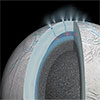 |
Methane in the plumes of Saturn's moon enceladus: Possible signs of life? |
| A study concludes that known geochemical processes can't explain the levels of methane measured by the Cassini spacecraft on Saturn's icy moon. | |
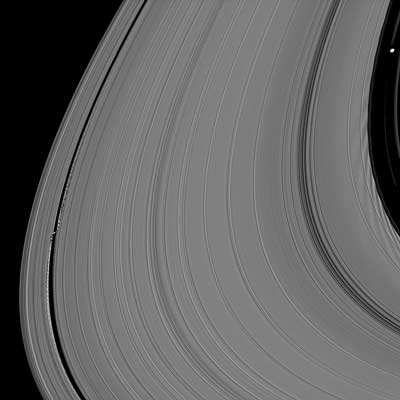 |
To keep Saturn's A ring contained, its moons stand united |
| For three decades, astronomers thought that only Saturn's moon Janus confined the planet's A ring -- the largest and farthest of the visible rings. But after poring over NASA's Cassini mission data, astronomers now conclude that the teamwork of seven moons keeps this ring corralled. | |
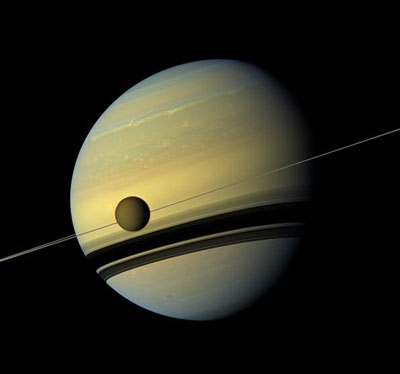 |
Insights into evolution of life on Earth from one of Saturn's moons |
| Glimpses of the nursery of life on Earth more than 3.5 billion years ago are coming from an unlikely venue almost 1 billion miles away, according to the leader of an effort to understand Titan, one of the most unusual moons in the solar system. | |
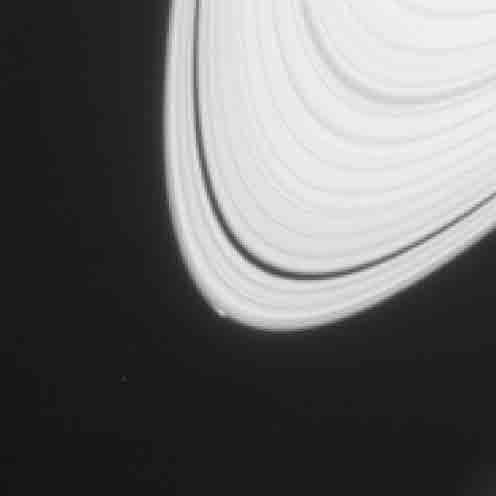 |
Cassini images may reveal birth of new Saturn moon |
| NASA's Cassini spacecraft has documented the formation of a small icy object within the rings of Saturn that may be a new moon, and may also provide clues to the formation of the planet's known moons. |
